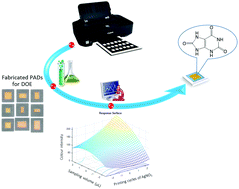Fabrication of paper-based analytical devices optimized by central composite design†
Abstract
In this work, an application of a design of experiments approach for the optimization of an isoniazid assay on a single-area inkjet-printed paper-based analytical device (PAD) is described. For this purpose, a central composite design was used for evaluation of the effect of device geometry and amount of assay reagents on the efficiency of the proposed device. The factors of interest were printed length, width, and sampling volume as factors related to device geometry, and amounts of the assay reagents polyvinyl alcohol (PVA), NH4OH, and AgNO3. Deposition of the assay reagents was performed by a thermal inkjet printer. The colorimetric assay mechanism of this device is based on the chemical interaction of isoniazid, ammonium hydroxide, and PVA with silver ions to induce the formation of yellow silver nanoparticles (AgNPs). The in situ-formed AgNPs can be easily detected by the naked eye or with a simple flat-bed scanner. Under optimal conditions, the calibration curve was linear in the isoniazid concentration range 0.03–10 mmol L−1 with a relative standard deviation of 3.4% (n = 5 for determination of 1.0 mmol L−1). Finally, the application of the proposed device for isoniazid determination in pharmaceutical preparations produced satisfactory results.



 Please wait while we load your content...
Please wait while we load your content...